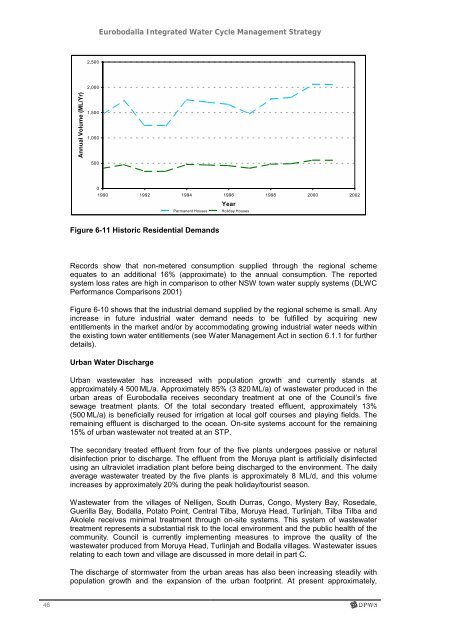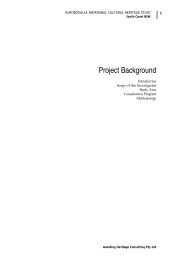Eurobodalla Integrated Water Cycle Management Strategy
Eurobodalla Integrated Water Cycle Management Strategy
Eurobodalla Integrated Water Cycle Management Strategy
You also want an ePaper? Increase the reach of your titles
YUMPU automatically turns print PDFs into web optimized ePapers that Google loves.
46<br />
Annual Volume (ML/Yr)<br />
2,500<br />
2,000<br />
1,500<br />
1,000<br />
500<br />
<strong>Eurobodalla</strong> <strong>Integrated</strong> <strong>Water</strong> <strong>Cycle</strong> <strong>Management</strong> <strong>Strategy</strong><br />
0<br />
1990 1992 1994 1996 1998 2000 2002<br />
Year<br />
Permanent Houses Holiday Houses<br />
Figure 6-11 Historic Residential Demands<br />
Records show that non-metered consumption supplied through the regional scheme<br />
equates to an additional 16% (approximate) to the annual consumption. The reported<br />
system loss rates are high in comparison to other NSW town water supply systems (DLWC<br />
Performance Comparisons 2001)<br />
Figure 6-10 shows that the industrial demand supplied by the regional scheme is small. Any<br />
increase in future industrial water demand needs to be fulfilled by acquiring new<br />
entitlements in the market and/or by accommodating growing industrial water needs within<br />
the existing town water entitlements (see <strong>Water</strong> <strong>Management</strong> Act in section 6.1.1 for further<br />
details).<br />
Urban <strong>Water</strong> Discharge<br />
Urban wastewater has increased with population growth and currently stands at<br />
approximately 4 500 ML/a. Approximately 85% (3 820 ML/a) of wastewater produced in the<br />
urban areas of <strong>Eurobodalla</strong> receives secondary treatment at one of the Council’s five<br />
sewage treatment plants. Of the total secondary treated effluent, approximately 13%<br />
(500 ML/a) is beneficially reused for irrigation at local golf courses and playing fields. The<br />
remaining effluent is discharged to the ocean. On-site systems account for the remaining<br />
15% of urban wastewater not treated at an STP.<br />
The secondary treated effluent from four of the five plants undergoes passive or natural<br />
disinfection prior to discharge. The effluent from the Moruya plant is artificially disinfected<br />
using an ultraviolet irradiation plant before being discharged to the environment. The daily<br />
average wastewater treated by the five plants is approximately 8 ML/d, and this volume<br />
increases by approximately 20% during the peak holiday/tourist season.<br />
Wastewater from the villages of Nelligen, South Durras, Congo, Mystery Bay, Rosedale,<br />
Guerilla Bay, Bodalla, Potato Point, Central Tilba, Moruya Head, Turlinjah, Tilba Tilba and<br />
Akolele receives minimal treatment through on-site systems. This system of wastewater<br />
treatment represents a substantial risk to the local environment and the public health of the<br />
community. Council is currently implementing measures to improve the quality of the<br />
wastewater produced from Moruya Head, Turlinjah and Bodalla villages. Wastewater issues<br />
relating to each town and village are discussed in more detail in part C.<br />
The discharge of stormwater from the urban areas has also been increasing steadily with<br />
population growth and the expansion of the urban footprint. At present approximately,

















